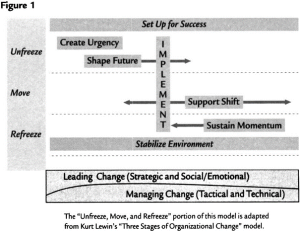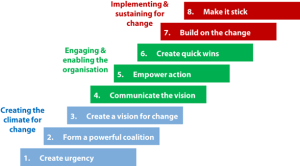Change management: the key to successful projects
When one talks about project management, change management is often mentioned almost immediately. But what does it exactly imply? How can one ‘manage change’, and do you need to have certain knowledge about this, or is external expertise necessary? The website techtarget.com, summarizes it as follows: “a systematic approach to dealing with the transition or transformation of an organization’s goals, processes or technologies” (Lawton & Pratt, 2022). This article gives depth into what change management entails as well as a brief history, what functions a ‘change management expert’ can fulfil, what the latest trends are around it are, and finally how technology in combination with this way of managing has changed throughout the years.
Change management throughout the years
One of the earliest change models was developed by social psychologist Kurt Lewin. Kurt describes three process stages:
- The first stage: “unfreezing”.
- This stage involves setting aside the existing mindset and preparing to change.
- The second stage: “Move”.
- The second stage is the stage where change happens. A period of transition and confusion takes place while adaptions occurs.
- The third and final stage: “Freeze/refreeze”.
- At the final stage, solidification of the new mindset and a return to pre-change comfort levels happens (Lewin, 1947).
The figure for this process is placed down below.
Figure 1: Kurt Lewin’s “three stages of organizational change” model (Carter, 2008)
The current definition
A very frequently used model for implementing change is the change management model by J.P. Kotter. Kotter describes 8 steps for which an organization must go through in order to successfully implement (organizational) change (Kotter, 2012). A brief explanation of the 8 steps:
- Create urgency.
- There needs to be urge for an actual change before anything is done.
- This could be done by identifying the company’s existing opportunities and goals, which a SWOT-analysis could be used for.
- Put a team together.
- Creating a strong team with all necessary skills as well as connections and authority for the wanted change must be established before actually doing other steps.
- There needs to be a culture of trust and commitment at all levels of the organization in order to gain trust in the process itself, as well as in the people within the company.
- A team may vary in size, depending on the type of (change) project that is being implemented.
- Develop vision and strategies.
- A clear vision for the company’s initiative needs to be put forward, as well as effective strategies that may help achieving this vision.
- This vision must be aligned with the core values of the organization. It must also be understandable by everyone (so don’t make things too complex). Finally, use all available company data to help the project to develop further: do market research, use company trends, and project data to help launching the project.
- Communicate the change vision.
- The vision must be communicated both internally (to its employees and affected people) and externally (to its stakeholders) to encourage support and acceptance around the project.
- Winning hearts and minds of employees is very important. Resistance will otherwise occur in some way, which is not useful for the continuation of the project.
- Encourage feedback, by taking employees in the process itself, asking for recommendations and other things that may help skyrocketing the project.
- All organizational channels are encouraged to be used to deliver the change vision.
- Managers and executives must “talk the talk”. Do what is expected from the employees yourself, so demonstrate the wanted behaviour at the top-levels of the organization.
- Remove obstacles.
- As mentioned in the previous step, resistance from stakeholders (both internal and external) may occur at some point. Making sure everyone is fully on board with the new vision is crucial to prevent, or in this case, fix the obstacle (resistance). Rewarding employees for good work and/or behaviour could be one step in fixing the resistance obstacle for example.
- Any other obstacles, like the execution of specific steps which is not going well or misunderstanding of the vision must be found and terminated quickly in order to achieve the best possible execution of the change project. It is therefore crucial to monitor the actual progress of the project, which can in turn be compared to the wanted progress of the project in a specific timeframe.
- Set short-term goals.
- It is very important to note that change takes time, and it is very much possible that the actual goals are achieved somewhere in the future, and not directly. Because of this, it is crucial to set short-term goals.
- Celebrate small goals with the entire team, to keep the motivation up. Maintaining momentum is crucial to eventually achieve the desired end-result.
- Break up the project in smaller parts, so that smaller achievements can be set. These smaller achievements can in turn be celebrated, and can be communicated within the company. Using all available channels is crucial here, so that everyone gets to know that the desired short-term goals are reached.
- Keep the momentum.
- In the previous step, momentum was already mentioned once. Other than celebrating smaller steps, the company must also determine what has worked and what has not worked in order to achieve the smaller short-term goals. By continuing with the things that work, and eliminating the things that don’t, momentum is maintained.
- Identification and elimination of unnecessary procedures and (inter)dependencies is therefore key to keep the momentum high.
- Make the change stick.
- After the change is finally implemented, the actual change must stick. A new culture regarding this change within the company must be created, where the change can be sustained.
- Organizational norms and values may be adjusted accordingly, as well as other components (like infrastructure, certain systems) to incorporate the change.
- The importance of the new changes must be communicated to all stakeholders, where the emphasis on the change must be communicated in a good way.
Finally, improve or even eliminate organizational procedures that do not match with the new culture (Kotter, 2012).
Figure 2: Kotter’s 8-step model of change presented visually (Lean six sigma group, sd).
Notes on the Kotter model
Even though the theory of Kotter is already more than 10 years old, it is still widely used within businesses to go through a process of change. There are a few notes on the theory, however:
- The theory’s attitude is all about a top-down approach. It is very important to keep everyone on board within a change project, otherwise resistance will most definitely occur. Instead of just giving out orders for employees to do a certain task, giving them a chance to lead could be just that extra bit of motivation to fully understand and be on board with the project. One might even discover themselves becoming a leader this way!
- The steps (and order) are not fixed. A company may very well have other needs or work in other ways that have also proven to work regarding changes. Certain parts of the theory can be used, while the order can be changed as well.
- The steps can be executed in various ways: by selecting a team of people within the company, or by hiring experts who have worked with the Kotter-theory and/or other change management approaches throughout the years in order to successfully implement change. The exact functions that a change management leader could execute, is discussed in the paragraph “Functions one can fulfil”.
For anyone interested into the details of the 8-step model, we refer you to the original source on the website of the Lean Six Sigma group.
Latest trends
Recent literature has proven some contradiction to the Kotter framework. A recent article by McLaren et al. for example state that even though the Kotter-model wants to create and/or improve trust between the company and the employees, the very same model also hugely relies on emphasizing that ‘change must occur since the building is on fire’: “More condemnation is launched by Hughes (Hughes, 2016) when he notes that Kotter promotes building trust between employee and organization as being a tenet for successful change, but at the same time, Kotter encourages the manufacturing of a crisis i.e. claim that the building is on fire” (McLaren, van der Hoorn, & Fein, 2022).
Next to this, the focus on employees and the individual as a whole is becoming increasingly important. This has been stated by a recent article (2022) in the journal of change management: “A typology of post-acquisition integration as the combination of task and human aspects (Birkinshaw, Bresman, & Håkanson, 2002) has become increasingly influential, and acquisition scholars have identified problems in sociocultural integration as a key cause for acquisition failures (e.g. (Raitis, Harikkala-Laihinen, Hassett, & Nummela, 2018)” (Harikkala-Laihinen, 2022).
The book “how to win friends and influence people” by Dale Carnegie stated back in 2006 that people are living creatures, and not machines, and thus should be treated so: “When dealing with people, let us remember we are not dealing with creatures of logic. We are dealing with creatures of emotion, creatures bristling with prejudices and motivated by pride and vanity” (Carnegie, 2006). It is therefore really important to look at the individual’s needs during a change management project, in order to get every single employee not on board with the project, but also to make sure the employee can work to its fullest potential.
Functions one can fulfil
Several papers and theories have proven that leadership within a change management project is key to achieve the desired outcome. Roger Gill, for example, published a paper back in 2003 which states that “while change must be well managed, it also requires effective leadership to be successfully introduced and sustained” (Gill, 2003). A change management role therefore often entails a management and/or leadership function.
The website prosci.com sums up a list of the possible ‘change management’ titles one can have. They are as follows:
- Advisor;
- Analyst (example: Business transition analyst, Organizational readiness analyst, Strategy realization analyst);
- Consultant;
- Coordinator;
- Facilitator;
- Lead (example: Business readiness lead, Organization adoption lead, Change realization lead);
- Manager (example: Business transformation manager, Benefit realization manager);
- Practitioner;
- Specialist (example: Implementation specialist). (Change Management Job Description, sd)
I also thought of the following (relevant and/or related) titles one can have regarding change management:
- Change manager;
- Project manager;
- (change) consultant;
- Scrum master (in the case that Scrum is used for a project);
- Agile coach;
- Lean (green/black) belt coach/facilitator (in the case of a project in which the Lean philosophy is the central theory).
Income of a change management expert
The salary of a change manager highly depends on the specific functionalities and responsibilities one has within a company. However, the general income seems to be between 36k and 132k for example, depending on experience, role and hours of working within a company. The following screenshot is an example of ‘change management jobs by salary’ according to the website payscale.com for the Netherlands:
Figure 3: Payscale example for ‘change management skill’ (payscale.com, 2023)
Another example for a ‘change management specialist’ according to the website salaryexpert.com for the Netherlands is as follows:
Figure 4: Mean income ‘change management specialist’ example (salaryexpert.com, 2023).
Conclusion & wrap-up
Change management is not only a very interesting theme to specialize in, it is also something almost every company will at least once have to deal with in their lifetime. The theory behind change management is dated from way back of 1947, when social psychologist Kurt Lewin described his ‘three stage process’ all the way to more recent theories like Kotter’s 8-step process.
Within change management, the emphasis on the people component has become increasingly important for not only companies, but also for the individual. It is therefore crucial to get every one of the employees on board with the change management project, to make sure they both understand the company’s vision as well as to make sure the employees can unleash their full potential.
Finally, salaries as a change manager can vary depending on several factors like experience, role, responsibilities and other factors, but in general the salaries are pretty high to start with. The exact name of the function one could fulfil differs a lot, but the general execution of the tasks have the very same base: going from an old situation to a new one.
References
Birkinshaw, J., Bresman, H., & Håkanson, L. (2002). Managing the post-acquisition integration process: How the human integration and task integration processes interact to foster value creation. Journal of Management Studies, 395-425.
Carnegie, D. (2006). How to win friends and influence people. New York: Pocket books.
Carter, E. (2008). Successful Change Requires More Than Change Management. The Journal for Quality and participation, 20-23.
Change Management Job Description. (sd). Opgeroepen op Maart 6, 2023, van prosci.com: https://www.prosci.com/resources/articles/change-management-job-description
Gill, R. (2003). Change management — or change leadership? Journal of Change Management, 307-318.
Harikkala-Laihinen, R. (2022). Managing Positive Change: Emotions and Communication Following Acquisitions. Journal of Change Management, 373-400.
Hughes, M. (2016). Leading changes: Why transformation explanations fail. Leadership, 449-469.
Kotter, J. (2012). Leading change. Boston: Harvard Business Review Press. Opgeroepen op Maart 6, 2023
Lawton, G., & Pratt, M. K. (2022, Mei). Change management. Opgeroepen op Maart 20, 2023, van techtarget.com: https://www.techtarget.com/searchcio/definition/change-management#:~:text=Change%20management%20is%20a%20systematic,people%20to%20adapt%20to%20change.
Lean six sigma group. (sd). Opgeroepen op Maart 6, 2023, van leansixsigmagroup.nl: https://leansixsigmagroep.nl/en/lean-agile-and-six-sigma/kotter/
Lewin, K. (1947). Frontiers in Group Dynamics 1. Human Relations, 5-41.
McLaren, T. A., van der Hoorn, B., & Fein, E. C. (2022). Why Vilifying the Status Quo Can Derail a Change Effort: Kotter’s Contradiction, and Theory Adaptation. Journal of Change Management, volume 23, 93-111.
payscale.com. (2023, Januari 23). Salary for Skill: Change Management. Opgehaald van payscale.com: https://www.payscale.com/research/NL/Skill=Change_Management/Salary
Raitis, J., Harikkala-Laihinen, R., Hassett, M., & Nummela, N. (2018). Socio-cultural integration in mergers and acquisitions: the Nordic approach. Turku: Birkenhauser Verlag Ag.
salaryexpert.com. (2023, Maart 6). Specialist Change Management. Opgehaald van salaryexpert.com: https://www.salaryexpert.com/salary/job/specialist-change-management/netherlands/amsterdam








